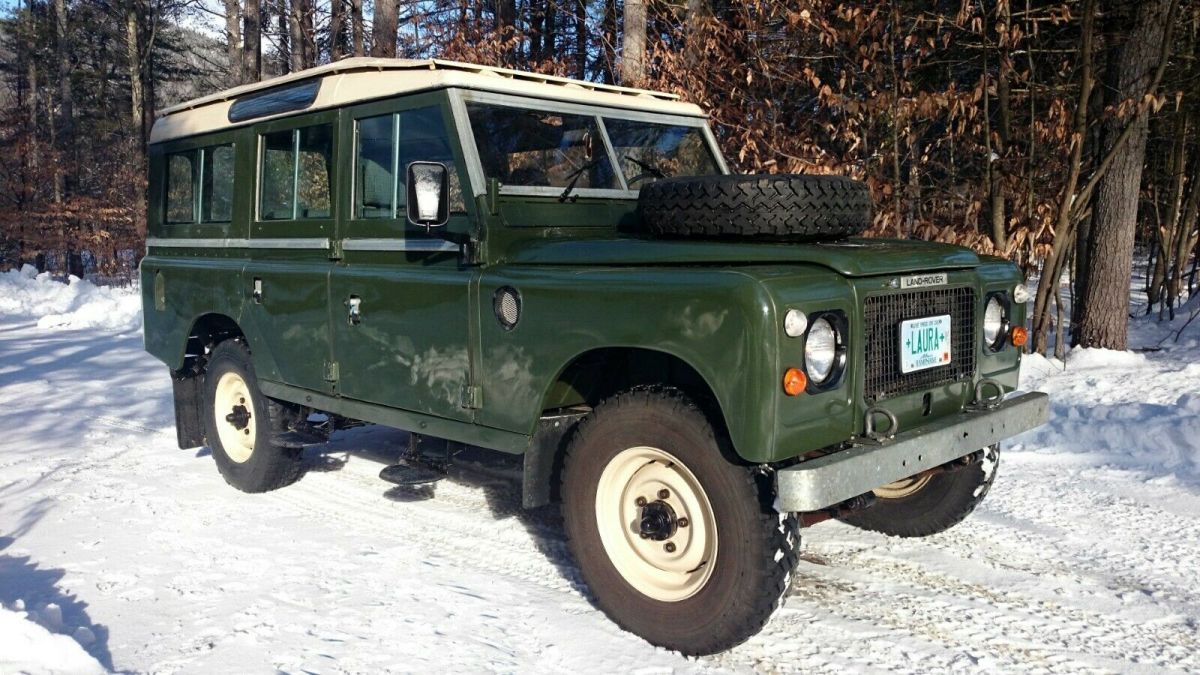1984 LAND ROVER SERIES 3 109 V8 STATION WAGON (STAGE ONE)
- Make: Land Rover
- Model: Defender
- Year: 1980
- Mileage: 48000
- VIN: SALLBCMV2AA196904
- Vehicle Title: Clean
- Location: Bartlett, New Hampshire, United States
Description
1984 LAND ROVER SERIES 3 109 V8STATION WAGON (STAGE ONE)(Note, I had to put the year as 1980 on the listing title because UK VIN number)
SALLBCMV2AA19604
Genuine left hand driveFull restoration 3 years agoimported from the UK October 2019Registered in New Hampshire with a new clean titleNew Hampshire state InspectedAll paper work present (U.S.Customs and Border Protection, EPA, DOT)
FRAMEThe frame was sand blasted and had a few minor welded repairs,
mostly to the top of the rear cross member before being painted in primer,
then was spray painted in a satin black frame paint.
BODYOnly the rear door outer panel was replaced, the rest of the body and the doors are original,
all the door frames have been repaired where needed. The interior door cards have been replaced with custom made panels cut from galvanizedsteel sheets so will not rot out like the original fiber board ones.The rear floor has new supportsBoth front doors and the rear door have new locks, the ignition barrel is new also. Two sets of keys.
SAFARI ROOF AND WINDOWSThe roof has been painted in the correct Limestone color, all the vents open and the interior roof lining is intact.All the windows are original and slide open and close as they should. Fitted with new runners.
ENGINEThe original v8 engine runs well, new valley gasket, oil change, serviced, cleaned with aluminum cleaner, fitted with a new starter motor, the carburetorshave been cleaned, the restrictors (factory fitted to these series 3 v8's) removed.Twin carburetorswith manual choke (cold start)
SEATSThe seats are in excellent condition, the seat covers have been removed and dry cleaned. Moorland cloth design.
The front driver and passenger seats have the high backs and head rests.
AXLES AND WHEELSOriginal leaf springs. Original front and rear heavy duty Salisbury axle.The genuine 16" steel wheels, sand blasted and painted in Limestone.
Wheels are fitted with brand new Avon range master radial tires (the correct size for this series 3 v8, r16 7.50)
BRAKES AND CLUTCHDrum brakes all round, the brake shoes are good, the cylinders have been replaced,
all new nickel plated brake lines.New clutch,slavecylinder and also new nickel plated clutch lines
ELECTRICS AND LIGHTSThe headlights, side lights and indicators are new. The dual reverse lights are original.The heater and fan works (when the engine has warmed up). All the lights and switches on the dash board work as they should, as does the interior light. Fitted with dual rear fog lights.Windshield wipers and washer works well, new washer pump fitted. New battery.
TRANSMISSIONFour speed Permanentfour wheel drive, LT95 transmission,
High and low differential works as is it should as does the diff lock.
LOCATIONThe Land Rover is located in the beautiful Mt Washington valley, New Hampshire.
Currently garaged due to the heavy use of rock salt up here in the winter.Registered, inspected and with a brand new clean title makes it easy to register in any State.
SALE10% deposit required after sale agreed, payment in full by bank transfer only.
Many thanks for viewing my very rare Land Rover,
genuine reason for sale (to invest in real estate)Any questions, please message me via ebay -Daniel.
More general information about this particular Land Rover make and model below...
LAND ROVER HISTORYThe Land Rover was conceived by the Rover Motor Company in 1946 during the aftermath of World War II. Rover's usual products were luxury cars which were not in demand in the immediate post-war period.
Rover's chief designer, Maurice Wilks, came up with a plan to produce a light agricultural and utility vehicle, of a similar concept to the Willys Jeep used in the war.
The bodywork was hand-made out of surplus aircraft grade aluminium, mainly an aluminium/magnesium alloy called Birmabright, to save on steel, which was closely rationed. Paint was also in short supply, resulting in the first production vehicles making use of army surplus green paint.
Originally the Land Rover was a single model offering, which from 1948 until 1951 used an 80 in wheelbase and a 1.6 litre petrol engine. It became known as the Series 1.
The successor to the Series 1, the Series II, came in 88 in and 109 in wheelbases (normally referred to as the 'SWB' and 'LWB'). This was the first Land Rover to receive the attention of Rover's styling department- Chief Stylist David Bache producing the familiar 'barrel side' waist.
Introduced in 1971 the Series III was to become the most popular of the Series vehicles. The headlights were moved to the wings and the traditional metal grille was replaced with a plastic one.
The simple metal dashboard of earlier models was redesigned to accept a new moulded plastic dash. The instrument cluster, which was previously centrally located, was moved to the driver's side.
By the late seventies though the time proven ruggedness, basic no thrills Series Land Rover was dated and facing stiff competition from well appointed Japanese imports and pressure from Middle Eastern consumers greedy for more horsepower.
Land Rover was the only division of BL that was making profit. However cash in the group was tight forcing Land Rover to approach Margaret Thatcher's government for the £200 million needed to produce and introduce the new Land Rover required if the company was to stand any chance against that emerging overseas competition and demand.
The new models were to become known as the Ninety and the One Ten and were to be introduced with new engines, transmissions, drive train and suspension along with much needed revised and improved trim levels.
However the Ninety and One Ten were barely on the drawing board by the late seventies and realistically production could not start until the early eighties. An interim solution/model to combat the pressing Japanese problem was urgently needed.
Range Rover was providing the majority of those Land Rover profits and was extremely popular in the Middle East - where the last thing on anyone's mind was fuel consumption.
In Solihull Land Rover planners began stage 1 of the two stage development of the new model. Experimenting by fitting the ever popular V8 Range Rover engine, gear box and drive train into the Series III, making it the only production Series Land Rover to ever have permanent four wheel drive. All in all a great success!
The 3.5 V8 permanent four wheel drive Series III (which un-officially became known as the Stage 1 from its development days) was launched in 1979.
Available only in the 109 Long Wheel Base format, it was soon to be recognised as the best and finest Series model ever produced. The new V8 (as it was officially called) offered a superb on road drive with a top speed of 80 MPH. It also offered, with exceptionally high torque, the best towing ability's and off road performance with its permanent 4 wheel drive of any Land Rover to date.
It was an immediate success in the very market that it was aimed at and, consequently, most production was focused on export models. However there was also a strong following at home and by the military.
LAND ROVER STAGE ONE ARTICLE COPIED FROM LAND ROVER OWNERS MAGAZINE...The legendary Rover V8 has been mated to countless icons of British desire throughout the decades, lurking under the bonnet of British Leyland’s various saving graces. The policeman-friendly Rover SD1, tarmac chewing TVR, riotous MG RV8 and ever-abused Sherpa van are just a few to have been propelled into the nostalgic status chamber by the all-conquering Buick-derived, eight-cylinder Rover beauty.
However, for numerous petrol heads - mainly the ones who enjoy a dirty weekend - the finest marriage will forever remain the Land Rover Series III Stage 1 V8. For a glorious six years, between 1979 and 1985, the mother of all Land Rovers was bolted together using components from across the Solihull range. The LT95 manual gearbox from the Range Rover Classic, the 3.5-litre V8 used in the military’s ‘bomb-proof’ box, the FC101 and chassis components from the globally respected Series vehicles all contributed to a marvellous concoction of fuel-crisis defying pleasure.
Known variously as the Series III Stage 1 V8, the Land Rover Stage 1 V8 and more simply as the Land Rover V8, ‘Stage 1’ actually referred to the first stage of investment from Margaret Thatcher’s Government to improve Land Rover’s product range by pumping in £200 million of tax payer’s money. This scheme eventually led to the development of the coil-sprung One Ten and Ninety models (Stage 2) and the diesel engines we have found ourselves besotted with ever since.Churning out a modest 91bhp from the de-tuned Range Rover Classic engine, but with enough torque to literally tear trees out of the ground or tow a building, the permanent four-wheel-drive, and the sheer grunt from this parts-bin beast took Land Rover in a new direction that set about defining the company for the next twenty years.Eye-popping colours helped too.
We aren’t sure how Mrs T. and her flaky government reacted behind closed doors to a car that looked practically identical to the pre-investment Series III, but the public adored them.
Various owners removed the restrictors on the V8 engine to allow all 135 ponies to strut their stuff, pushing the vehicle well beyond Land Rover’s threshold of on-road safety. Even when standard, the V8 was enough to get you into a great deal of trouble, and offering the usual frighteningly vague ride at speed, the higher cruising pace now possible could provoke angles of lean that made the Tower Pisa stand up straight and take notice.
Yet, in the right hands, the Stage 1 was unstoppable – that’s drum brakes for you. Popular with mountain rescue teams and emergency services the world over, the steroid-fed Series variant maintained the Land Rover tradition of taking pregnant mothers through snow storms to hospital, carting equipment through flood waters, preserving rare animals from extinction and providing relief in war zones–alongside remaining the farmers’ friend, who couldn't care less about the fuel bill.
In the classic car world, these are the Land Rovers to own. As far as beefy all-terrain vehicles go, the Series III Stage 1 V8 Land Rover is the undisputed king of the bunch.
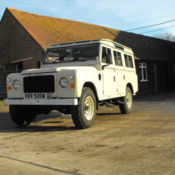 Land Rover Defender Series 109 STAGE ONE V8 5 door county station wagon 1981
Land Rover Defender Series 109 STAGE ONE V8 5 door county station wagon 1981
Mileage: 56,000
 RAREST 1984 Series III Land Rover Defender 109" 5-door Station Wagon
RAREST 1984 Series III Land Rover Defender 109" 5-door Station Wagon
Mileage: 189,237
 RARE 1984 Series III Land Rover Defender 109" 5-door Station Wagon
RARE 1984 Series III Land Rover Defender 109" 5-door Station Wagon
Mileage: 189237
 1974 Land Rover Series III Station Wagon
1974 Land Rover Series III Station Wagon
Mileage: 44,350
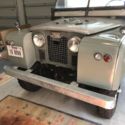 1966 Land Rover Series IIA Station Wagon
1966 Land Rover Series IIA Station Wagon
Mileage: 35638
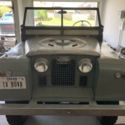 1966 Land Rover Series IIA 88” Station Wagon
1966 Land Rover Series IIA 88” Station Wagon
Mileage: 35000
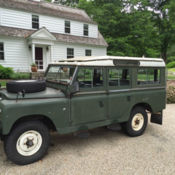 1962 Land Rover Series IIA Station Wagon
1962 Land Rover Series IIA Station Wagon
Mileage: n/a
 1979 LAND ROVER Series III 109" Station Wagon
1979 LAND ROVER Series III 109" Station Wagon
Mileage: 102,200
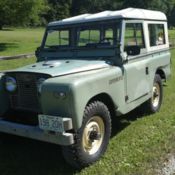 1961 series iia land rover station wagon
1961 series iia land rover station wagon
Mileage: 59,310
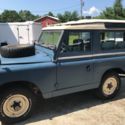 1965 Land Rover Series IIa Station Wagon
1965 Land Rover Series IIa Station Wagon
Mileage: 70700
